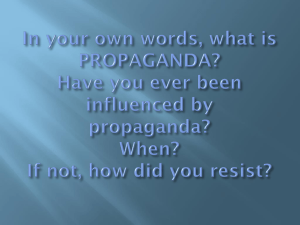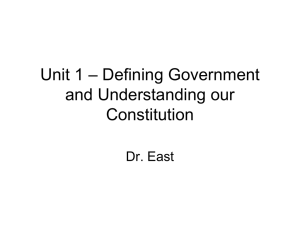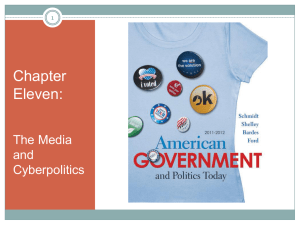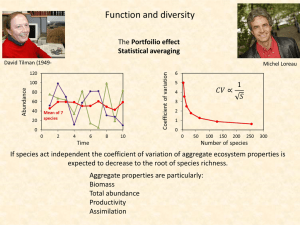unit5_workplace_communication_me
advertisement
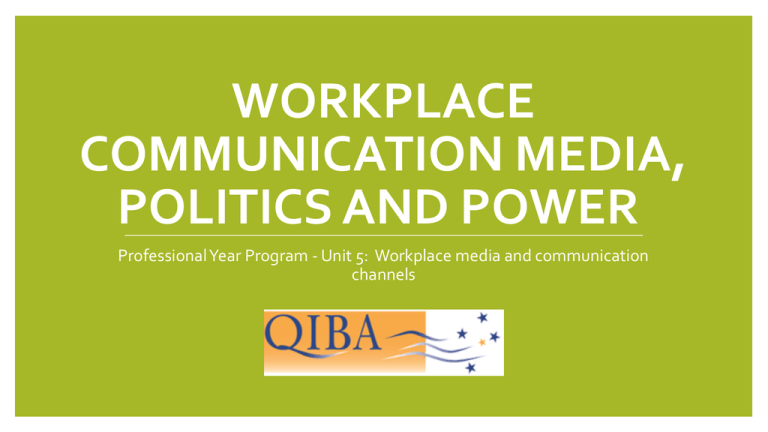
WORKPLACE COMMUNICATION MEDIA, POLITICS AND POWER Professional Year Program - Unit 5: Workplace media and communication channels Purpose The purpose of this session is to highlight the importance of using the right communication channel/media when communicating in the workplace. We will begin by revisiting the communication process, then we will consider the various communication channels and their differences, look at communication networks in organisations and identify common barriers to effective communication. The session will conclude with exploring the impact of power and politics in the workplace. Overview In this session we will cover the following: The communication process Communication media/channels Information richness and choice of media/channel Communication networks Common barriers to effective communication Power and politics in the workplace The Communication Process http://agilevietnam.com/tag/skills-2/ Encoding – Verbal & Nonverbal • Verbal Communication • The encoding of messages into words, either written or spoken • Nonverbal • The encoding of messages by means of facial expressions, body language, and styles of dress. Communication Channels What are the different communication channels that exist in the workplace? Communication Channels What are the communication channels that exist in the workplace? Can you think of others? Face to face Letters Reports Meetings Telephone Emails Videoconferencing Blogs/Forums Information Richness Different communication channels have different levels of information richness. It is important to select the communication channel that will provide the level of information richness you need to effectively communicate your message. Information Richness Information Richness Communication Media Face-to-Face Has highest information richness. Can take advantage of verbal and nonverbal signals Communication Media Spoken Communication Electronically Transmitted • Has the second highest information richness. • Telephone conversations are information rich with tone of voice, sender’s emphasis, and quick feedback, but provide no visual nonverbal cues. Communication Media Personally Addressed Written Communication • Has a lower richness than the verbal forms of communication, but still is directed at a given person. • Personal addressing helps ensure receiver actually reads the message—personal letters and e-mail are common forms. Communication Media Personally Addressed Written Communication • Has a lower richness than the verbal forms of communication, but still is directed at a given person. • Personal addressing helps ensure receiver actually reads the message—personal letters and e-mail are common forms. Communication Media Impersonal Written Communication • Has the lowest information richness. • Good for messages to many receivers where little or feedback is expected (e.g., newsletters, reports) Communication Media – Tips for choosing written or verbal Communication Networks Communication networks consider how information flows between people, teams and within an organisation. They can be descried as the pathways which information flows in groups and teams and throughout the organisation. Communication Networks – Groups Communication Networks - Organisation Organisation Chart • Summarises the formal reporting channels in an organisation. • Communication in an organization flows through formal and informal pathways • Vertical communications flow up and down the corporate hierarchy. Communication Networks - Organisation Organisation Chart • Horizontal communications flow between employees of the same level. • Informal communications can span levels and departments—the grapevine is an informal network carrying unofficial information throughout the firm. Communication Networks - Organisations Formal and Informal Communication Networks in an Organisation (see next slide) Common Barriers to Effective Communication • Messages that are unclear, incomplete, difficult to understand • Messages sent over the an inappropriate medium • Messages with no provision for feedback • Messages that are received but ignored • Messages that are misunderstood • Messages delivered through automated systems that lack the human element Power and Politics in the Workplace Power and politics are part of any group or organisation to varying degrees. An awareness of these factors is critical in successfully navigating a organisation and communicating effectively. Power and Politics in the Workplace Power • What is power in the workplace? • The capacity someone has to influence the behaviour of another • What are some examples of power in the workplace? • Is power good or bad? Power and Politics in the Workplace Power Types of Power Formal Personal Formal Power Positional Power Personal Power I like you…. Power and Politics in the Workplace Politics • What is politics in the workplace? –Activities that are not part of a persons formal job, • but that influence the distribution of advantages What are some examples of politics in the workplace? • Are politics good or bad? Power and Politics in the Workplace Politics Watch the following video on office politics Identify two ways you can respond positively to office politics Watch Video – Office Politics Power and Politics in the Workplace Power and Politics in the Workplace Debrief : Video – Office Politics Identify two ways you can respond positively to office politics

